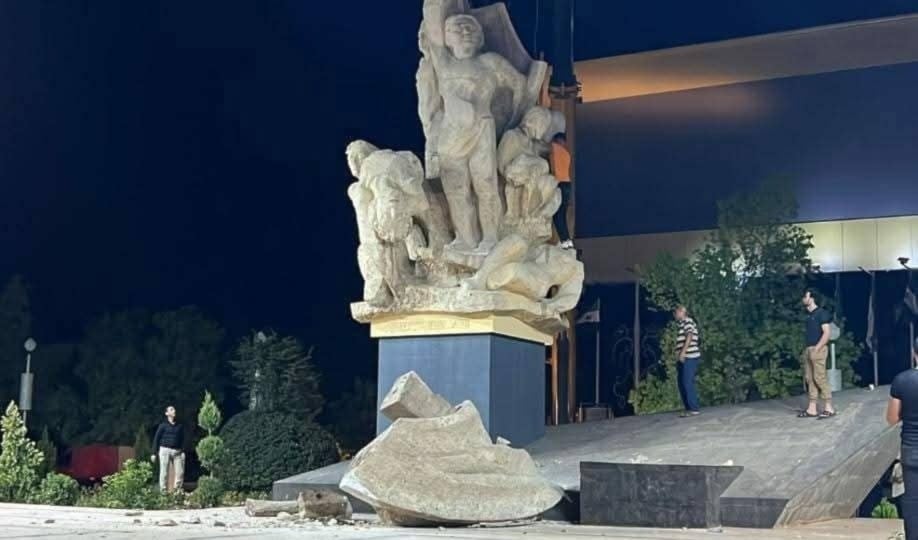Martyrs’ statue destroyed in Aleppo, stirring controversy
The collapse of the Martyrs' Statue in central Aleppo has stirred debate over heritage preservation and political memory, with officials and residents offering conflicting narratives.
-

A piece of the Martyrs' Monument can be seen on the floor as it is being destroyed, Aleppo, Syria, July 2, 2025 (social media)
The toppling of the "Martyrs' Statue" in Aleppo's central Saadallah al-Jabiri Square has stirred debate across Syria, following the circulation of footage capturing the moment its upper section collapsed on Wednesday night.
The footage shows a crane tugging at the statue with steel cables until its upper section snaps and plummets to the ground, an act condemned by activists as "degrading," while social media users erupted in outrage, accusing the demolition of disrespecting the monument's historical significance.
أثار تحطيم "تمثال الشهداء" في ساحة سعد الله الجابري وسط مدينة حلب الجدل في #سوريا، بعد تداول مقطع مصوّر يُظهر لحظة تحطم الجزء العلوي منه مساء الأربعاء.
— قناة الميادين (@AlMayadeenNews) July 3, 2025
وعبّر رواد مواقع التواصل الاجتماعي عن غضبهم واستيائهم من تحطيم التمثال، ورأوا أن ذلك استخفاف بقيمته.
وتعليقاً على الحادثة،… pic.twitter.com/WLpEDJxAsQ
Commenting on the incident, Aleppo Governor Azzam Gharib took to X, asserting that the scenes "exposed clear mishandling during the transfer of the structure in Saadallah al-Jabiri Square," referring to what the former regime had labeled the "Martyrs' Statue."
He assured the people of Aleppo that the incident was completely unacceptable by any measure, emphasizing that the party responsible for carrying out the transfer would bear full accountability for failing to follow the pre-established technical and structural guidelines.
Statue removal sparks heritage debate
He explained that the approval to relocate the monument to the museum had been granted based on a proposal submitted by Aleppo's city council in coordination with the Directorate of Antiquities, as part of a broader project to rehabilitate the square and transform it into a vibrant cultural space.
The governor claimed that the relocation initiative came about following appeals from community members who viewed the monument as an unwelcome reminder of the city's difficult past, particularly the oppressive actions taken by the previous government during the 1982-1984 period that continue to haunt residents' collective consciousness.
He further explained that despite differing opinions about the monument's significance, authorities had insisted that the relocation be conducted with precision and safety under expert supervision to preserve any historical or documentary value it might hold.
The governor dismissed rumors of any ideological basis for the move as completely unfounded, stressing that the statue's relocation was simply part of a municipal development strategy grounded in practical surveys and public opinion.
He announced immediate plans to restore the damaged sections before properly preserving the monument in the museum, emphasizing his commitment to safeguarding Aleppo's ancient heritage and ensuring all projects reflect professionalism, discipline, and respect for the city's history.
People remain skeptical of the official explanation
The official narrative failed to convince many, especially after images circulated showing the statue in ruins, prompting activists and residents to demand a transparent investigation into the circumstances surrounding the incident while calling for accountability and the restoration of the monument to its original state.
The company overseeing Saadallah al-Jabiri Square's rehabilitation project had previously released new designs that conspicuously excluded the monument, sparking outrage among residents and activists who interpreted this omission as clear evidence of premeditated removal plans.

 3 Min Read
3 Min Read










